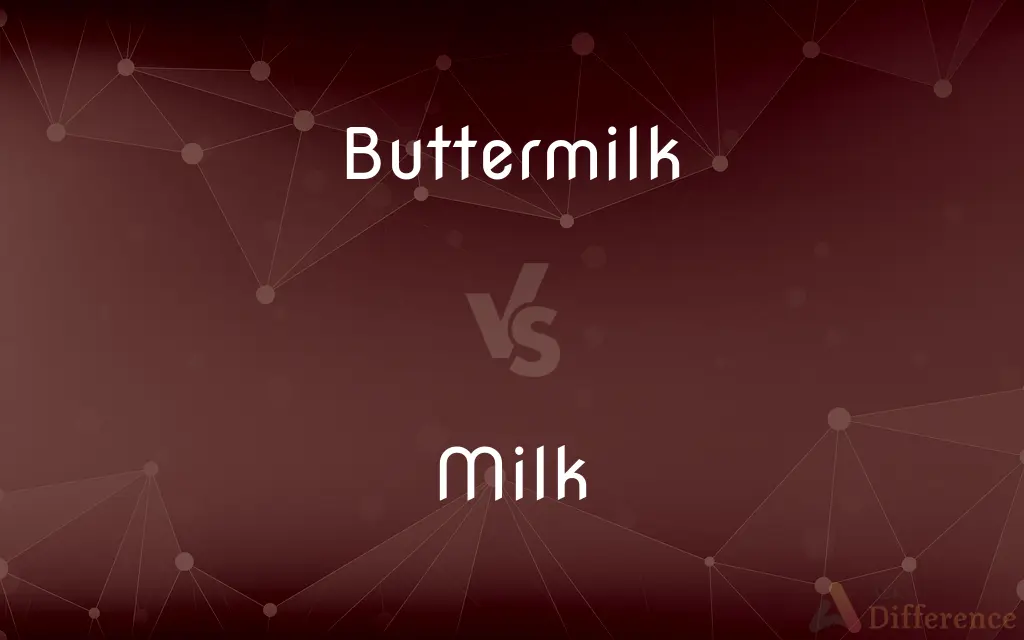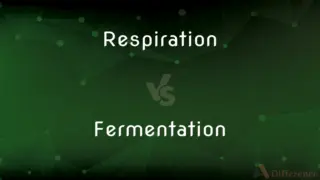Buttermilk vs. Milk — What's the Difference?
By Tayyaba Rehman — Updated on September 23, 2023
Buttermilk is the tangy liquid left after churning butter, while milk is the nutrient-rich liquid produced by mammals. Milk is creamier and has a neutral taste, whereas buttermilk is sourer and thinner.

Difference Between Buttermilk and Milk
Table of Contents
ADVERTISEMENT
Key Differences
Buttermilk is a byproduct of the butter-making process. After churning butter from cream, the liquid that remains is buttermilk. It possesses a sour, tangy flavor and is often used in baking due to its acidity. Milk, in contrast, is a white, creamy liquid that mammals produce to nourish their young.
When you consider their consistency, milk is naturally creamier and thicker than buttermilk. The fats present in milk are what give it its rich texture. Buttermilk, having had the fat content reduced during churning, is comparatively thinner. Milk is versatile and is consumed directly, while buttermilk is primarily used in cooking and baking.
In terms of nutritional content, both buttermilk and milk offer a range of vitamins and minerals. Milk is rich in calcium, protein, and vitamin D, serving as a primary source of these nutrients for many. Buttermilk, though lower in fat due to the churning process, still retains some of the beneficial nutrients found in milk.
Taste-wise, milk is often described as having a neutral, slightly sweet flavor, especially in the case of mammalian milk like cow's or goat's milk. Buttermilk has a distinctly sour taste because of the fermentation process it undergoes. This unique flavor profile makes it desirable in certain recipes, giving baked goods a soft texture and tangy flavor.
Comparison Chart
Origin
Liquid left after churning butter
Liquid produced by mammals
ADVERTISEMENT
Consistency
Thinner due to reduced fat
Creamier and thicker
Flavor
Tangy and sour because of fermentation
Neutral to slightly sweet
Primary Uses
Cooking, baking, and certain beverages
Direct consumption, dairy products, cooking, and baking
Nutritional Content
Lower in fat, retains some vitamins and minerals from milk
High in calcium, protein, vitamin D, and fats
Compare with Definitions
Buttermilk
A slightly sour milk fermented by bacteria.
This recipe requires buttermilk for the best flavor.
Milk
An essential ingredient in many recipes and dishes.
I added two cups of milk to the soup for creaminess.
Buttermilk
A tangy beverage consumed in various cultures.
On hot days, I enjoy a refreshing glass of spiced buttermilk.
Milk
Can be processed to produce cheese, butter, and yogurt.
The farmer used cow's milk to make delicious cheese.
Buttermilk
Often used to tenderize meats in culinary preparations.
The chicken was marinated in buttermilk overnight for tenderness.
Milk
Milk (also known in unfermented form as sweet milk) is a nutrient-rich liquid food produced by the mammary glands of mammals. It is the primary source of nutrition for young mammals, including breastfed human infants before they are able to digest solid food.
Buttermilk
The liquid residue after butter has been churned.
I used the buttermilk left from our homemade butter in the pancake batter.
Milk
An opaque white fluid rich in fat and protein, secreted by female mammals for the nourishment of their young
A healthy mother will produce enough milk for her baby
Buttermilk
Used in baking for its acidic properties.
Buttermilk gives the cake a soft and fluffy texture.
Milk
Draw milk from (a cow or other animal), either by hand or mechanically
Two hours later he was up again to milk the cows
I had to start the milking
Buttermilk
Buttermilk is a fermented dairy drink. Traditionally, it was the liquid left behind after churning butter out of cultured cream; however, as most modern butter is made not with cultured cream, but with sweet cream, most modern buttermilk is cultured.
Milk
Exploit or defraud by taking small amounts of money over a period of time
Executives milked the health plan's funds for their personal use
Buttermilk
The liquid, usually either naturally soured or cultured with acid-producing bacteria, that remains after the butterfat has been removed from cream by churning.
Milk
A whitish liquid containing proteins, fats, lactose, and various vitamins and minerals that is produced by the mammary glands of all mature female mammals after they have given birth and serves as nourishment for their young.
Buttermilk
A sour milk made by culturing usually skim milk with acid-producing bacteria.
Milk
The milk of cows, goats, or other animals, used as food by humans.
Buttermilk
The liquid left over after producing butter from full cream milk by the churning process, also called traditional buttermilk.
Milk
Any of various potable liquids resembling milk, such as coconut milk or soymilk.
Buttermilk
Cultured buttermilk, a fermented dairy product produced from cow's milk, with a characteristically sour taste.
Milk
A liquid resembling milk in consistency, such as milkweed sap or milk of magnesia.
Buttermilk
The milk that remains after the butter is separated from the cream.
Milk
To draw milk from the teat or udder of (a female mammal).
Buttermilk
Residue from making butter from sour raw milk; or pasteurized milk curdled by adding a culture
Milk
To draw or extract a liquid from
Milked the stem for its last drops of sap.
Milk
To press out, drain off, or remove (a liquid)
Milk venom from a snake.
Milk
To draw out or extract something from
Milked the witness for information.
Milk
To obtain money or benefits from, in order to achieve personal gain; exploit
"The dictator and his cronies had milked their country of somewhere between $5 billion and $10 billion" (Russell Watson).
Milk
To obtain the greatest possible advantage from (a situation).
Milk
To get the greatest effect from (a line or scene in a play, for example).
Milk
To yield or supply milk.
Milk
To draw milk from a female mammal.
Milk
(uncountable) A white liquid produced by the mammary glands of female mammals to nourish their young. From certain animals, especially cows, it is also called dairy milk and is a common food for humans as a beverage or used to produce various dairy products such as butter, cheese, and yogurt.
Skyr is a product made of curdled milk.
Milk
A white (or whitish) liquid obtained from a vegetable source such as almonds, coconuts, oats, rice, and/or soy beans.
Milk
An individual serving of milk.
Table three ordered three milks.
Milk
An individual portion of milk, such as found in a creamer, for tea and coffee.
I take my tea with two milks and two sugars.
I take my tea with two milk and two sugar.
Milk
The ripe, undischarged spat of an oyster.
Milk
Semen.
Milk
(transitive) To express milk from (a mammal, especially a cow).
The farmer milked his cows.
Milk
To draw (milk) from the breasts or udder.
To milk wholesome milk from healthy cows
Milk
To secrete (milk) from the breasts or udder.
Milk
(transitive) To express a liquid from a creature.
The Australian government has a team that regularly milks various snakes for venom to use creating serums and antivenoms.
Milk
To make excessive use of (a particular point in speech or writing, a source of funds, etc.); to exploit; to take advantage of (something).
When the audience began laughing, the comedian milked the joke for more laughs.
Milk
(of an electrical storage battery) To give off small gas bubbles during the final part of the charging operation.
Milk
To single-mindedly masturbate a male to ejaculation, especially for the amusement or satisfaction of the masturbator rather than the person masturbated.
Controlled milking can actually establish and consolidate a mistress’s dominance over her sub rather than diminish it.
Milk
A white fluid secreted by the mammary glands of female mammals for the nourishment of their young, consisting of minute globules of fat suspended in a solution of casein, albumin, milk sugar, and inorganic salts.
Milk
A kind of juice or sap, usually white in color, found in certain plants; latex. See Latex.
Milk
An emulsion made by bruising seeds; as, the milk of almonds, produced by pounding almonds with sugar and water.
Milk
The ripe, undischarged spat of an oyster.
Milk
To draw or press milk from the breasts or udder of, by the hand or mouth; to withdraw the milk of.
I have given suck, and knowHow tender 't is to love the babe that milks me.
Milk
To draw from the breasts or udder; to extract, as milk; as, to milk wholesome milk from healthy cows.
Milk
To draw anything from, as if by milking; to compel to yield profit or advantage; to plunder.
They [the lawyers] milk an unfortunate estate as regularly as a dairyman does his stock.
Milk
To draw or to yield milk.
Milk
To give off small gas bubbles during the final part of the charging operation; - said of a storage battery.
Milk
A white nutritious liquid secreted by mammals and used as food by human beings
Milk
Produced by mammary glands of female mammals for feeding their young
Milk
A river that rises in the Rockies in northwestern Montana and flows eastward to become a tributary of the Missouri River
Milk
Any of several nutritive milklike liquids
Milk
Take milk from female mammals;
Cows need to be milked every morning
Milk
Exploit as much as possible;
I am milking this for all it's worth
Milk
Add milk to;
Milk the tea
Milk
A white liquid produced by mammals to feed their young.
The cat nursed her kittens with her milk.
Milk
A primary source of calcium and vitamin D for humans.
Drinking milk helps strengthen bones and teeth.
Milk
Consumed in various forms, including skimmed, whole, and flavored.
Every morning, I have a glass of chocolate milk.
Common Curiosities
Can I substitute milk for buttermilk in a recipe?
It depends on the recipe. For some, you can use milk with added vinegar or lemon juice as a substitute.
Can I drink buttermilk straight?
Yes, in many cultures, buttermilk is consumed as a beverage.
Is milk a good source of protein?
Yes, milk is a rich source of protein.
Is lactose present in both milk and buttermilk?
Yes, both contain lactose, but the content might vary.
Why does buttermilk taste sour?
Buttermilk has a tangy flavor due to the fermentation process or from the acids left after churning butter.
Why is milk considered a staple in many diets?
Milk is nutrient-rich, offering calcium, protein, and vitamins essential for growth.
Can buttermilk be used in desserts?
Absolutely! Buttermilk can add a tangy flavor and soft texture to many desserts.
Which is fattier, milk or buttermilk?
Milk typically has more fat, as buttermilk has reduced fat from the butter-churning process.
Is buttermilk just sour milk?
Not exactly. While buttermilk is tangy, it's a specific byproduct of the butter-making process or fermented milk.
What's the shelf life of milk vs. buttermilk?
Both have limited shelf lives, but this varies based on factors like pasteurization.
Can you make buttermilk from milk?
Yes, by adding an acid like vinegar or lemon juice to milk.
Do both milk and buttermilk come from cows?
Typically, yes, but both can also come from other mammals like goats.
Which is better for bone health, milk or buttermilk?
Both are beneficial, but milk is usually a primary source of calcium and vitamin D.
Why is buttermilk often used in baking?
Its acidity can react with baking soda to produce carbon dioxide, making baked goods rise.
Are there non-dairy versions of milk and buttermilk?
Yes, there are plant-based milks. For buttermilk, you'd need to replicate its tangy flavor and acidity.
Share Your Discovery

Previous Comparison
Respiration vs. Fermentation
Next Comparison
Cite vs. SightAuthor Spotlight
Written by
Tayyaba RehmanTayyaba Rehman is a distinguished writer, currently serving as a primary contributor to askdifference.com. As a researcher in semantics and etymology, Tayyaba's passion for the complexity of languages and their distinctions has found a perfect home on the platform. Tayyaba delves into the intricacies of language, distinguishing between commonly confused words and phrases, thereby providing clarity for readers worldwide.














































